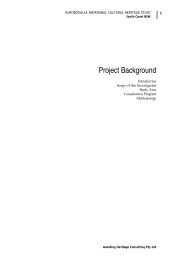Eurobodalla Integrated Water Cycle Management Strategy
Eurobodalla Integrated Water Cycle Management Strategy
Eurobodalla Integrated Water Cycle Management Strategy
Create successful ePaper yourself
Turn your PDF publications into a flip-book with our unique Google optimized e-Paper software.
128<br />
<strong>Eurobodalla</strong> <strong>Integrated</strong> <strong>Water</strong> <strong>Cycle</strong> <strong>Management</strong> <strong>Strategy</strong><br />
moving to permanently live in them (i.e. retiring effect of baby boomers). Due to<br />
development pressure, Council is investigating additional land areas that may be suitable<br />
for urban subdivision. Although the timing of development of the various areas cannot be<br />
predicted with certainty, it is accepted that the adopted population increase is sustainable.<br />
Although Council’s current planning instruments allow for medium density and cluster<br />
development, limits have been placed on building heights and population to floor space<br />
ratio. To secure the built-up character of the future, Council is working with Planning NSW<br />
to develop better and sustainable building envelopes and designs. Census figures show<br />
that the age profile of the population spreads evenly between the age group 0–60 years.<br />
Existing <strong>Water</strong> <strong>Management</strong> Systems<br />
The Batemans Bay area is supplied by the regional water supply scheme, with Denhams<br />
Beach service reservoir acting as the main storage. Denhams Beach supports a network of<br />
local service reservoirs, the Long Beach reservoir services the area north of Clyde River,<br />
the Batemans Bay and Catalina No. 2 reservoirs for the central area and the Lilli Pilli, Surf<br />
Beach and Malua Bay reservoirs supply to the southern area.<br />
A centralised sewage treatment plant located north west of Lilli Pilli services the whole<br />
Batemans Bay area. The plant provides secondary treatment of the sewage and is based<br />
on the continuous extended aeration process. The majority of the secondary treated<br />
wastewater is returned to the environment through direct ocean discharge after natural<br />
(pond) disinfection. Up to about 10% of the dry weather reclaimed water is reused on<br />
Catalina Golf Club. The de-watered and stabilised biosolid is used for rehabilitating<br />
Council’s landfill.<br />
The sewer network servicing this area is extensive and has been grouped into three distinct<br />
catchments:<br />
The northern catchment serving the area north of Clyde River<br />
The central catchment covering the central commercial areas, and<br />
The southern catchment servicing the Lilli Pilli and Malua Bay areas (south of STP).<br />
The northern catchment has about 10 pumping stations located along the bay foreshore<br />
and conveys the sewage towards the treatment plant. The central catchment has about 30<br />
pumping stations along the foreshore and a major station that receives the sewage<br />
generated from both the local and north catchments. The sewage from the main pump<br />
station is transferred direct to the treatment plant. The southern catchment also has about<br />
10 pumping stations and a main station, which transfers the collected sewage to the<br />
treatment plant.<br />
The <strong>Eurobodalla</strong> Stormwater <strong>Management</strong> Plan has divided the area into 18 subcatchments<br />
(see Figure 9-6).<br />
The sub-catchments to the north of Clyde River are predominantly residential. The runoff<br />
from these catchments stems predominantly from house roofs, impervious driveways and<br />
the road network. There are about 1.2 km of pipeline and 501 pits. The stormwater from<br />
these sub-catchments north of the Clyde River drains to Cullendulla Creek and the ocean.<br />
The land use of the seven central sub-catchments is mainly commercial and more than<br />
80% of the area is impervious. There are about 4.83 km of stormwater pipeline and 1 576<br />
pits. The stormwater from two of the sub-catchments drains to the ocean through Wimbie<br />
Creek, Joes Creek and the other subcatchments drain directly to the ocean.<br />
The land use of the six southern sub-catchments is predominantly residential. There are<br />
about 1.13 km of pipeline and 35 pits. The stormwater from two of the sub-catchments<br />
drains to a wetland, and the other sub-catchments drain directly to the ocean.

















